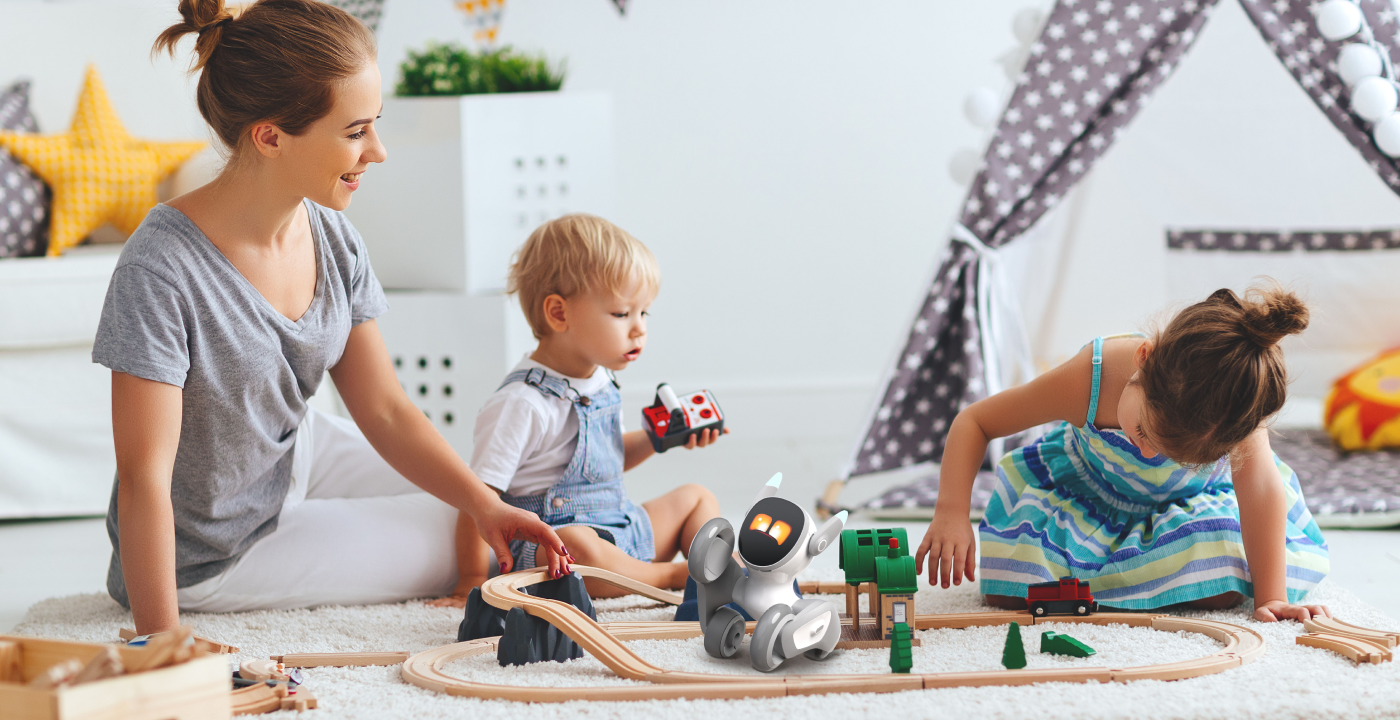Imagine a puppy that in no way desires feeding, doesn't cause allergies, and is always equipped to play. That's the magic of AI pets—robotic or digital partners designed to mimic actual animals with the use of artificial intelligence. From reasonable robotic puppies to interactive virtual pets, those digital companions are transforming how we enjoy pet ownership.
Today's AI partner robots are far superior, offering practical actions, emotional responses, and even systems that gain knowledge to adapt to their owners. Whether you're seeking out a robotic puppy to maintain your employer or a digital puppy game for leisure, AI pets offer precise advantages that real animals can't constantly provide.
Why AI Pets Are Gaining Popularity
People are resorting to AI pets for some reasons:
Hectic schedules: People are not all able to spend time on the needs of a real pet.
Housing bans and/or Allergies. Most apartments do not allow pets, and an allergy makes real animals out of the question.
The aged population of older adults enjoys the pledge of companionship without the physical importance of a real pet.
Mental health care. Robotic pets demonstrate an ability to lessen stress and loneliness.
What Are AI Pets?
AI pets are artificially intelligent pets that are programmed to exhibit animal-like behaviours and characteristics. Such pets may vary in size, with fully automated robot pets on one side, like the Aibo created by Sony, to virtual pet applications like the Nintendogs or Tamagotchi. In contrast to biological pets, AI pets do not need to be fed or groomed and treated with medical care, but continue to provide emotional support and companionship.
Top Benefits of AI Pets
1. Overcome Loneliness & Enhance Mental Health
The issue of loneliness is an increasing epidemic, as evidenced by the elderly population and the work-at-home crowd. Mental health. For example, therapeutic robotic seals such as Paro have been proven to lessen anxiety and depression through an AI pet. As opposed to real pets, they offer companionship, which never ceases, unlike the living animals that are unpredictable.
2. Seniors and those with Disabilities would do just fine.
Caring for a real pet may be difficult, especially for an elderly person or one who has mobility problems. Robotic pets, Joy for All cats and dogs, are lovable creatures that provide comfort without going out to walk or visit the vet. Even hospitals and care facilities apply them in treating dementia patients since they enable positive emotional reactions.
3. Barrier-Free, Low-Maintenance Alternative
No mess, no litter box, no vet cost, nothing is better than an AI pet. They are also ideal for persons with allergies or those travelling.
4. Interactive and Lifelike Company
Contemporary creatures in the form of companion robots, such as Sony Aib,o have cameras and sensors, detect faces, learn habits, and obey instructions. Some even "develop" unique behaviours based on interactions, making them feel surprisingly real.
5. Pediatric Ailment & Autism Advantage
Children who have autism tend to relate well with predictable and non-judgmental friends. Robotic pets are soothing, and they may play a beneficial role in social work. Virtual pet games and responsibility also go hand-in-hand in which the responsibility is fun and unstressing.
Types of AI Pets Available Today
Robotic Pets: More Than Machinery
The latest robotic pets are the work of engineering, integrated AI, and ostensibly believable behaviours in an effort to discover a highly realistic interactive pet.
Take Sony's Aibo, for example—this robotic dog doesn't just walk and bark; it learns its owner's habits, recognizes faces, and even develops a "personality" based on interactions. Aibo can navigate its way around a room with complex sensors, not to mention getting around furniture and even making physical contact with something, all in a plausible manner.
Last but not least, we have Lovot, a fluffy Japanese robot which is created only for emotional bonding.
-
Compared to a robot pet, Love is not functioning like a well-programmed machine that needs to be given a job to accomplish a task, such as fetching or cleaning
-
it is just there to keep you warm and loved.
-
With big, expressive eyes and a soft exterior, it reacts to hugs, follows people around, and even "sleeps" when tired.
These types of robots change the game, where people can get companionship without any responsibility.
For elderly people, Joy for All robotic cats and dogs can be an alternative that is kinder. The animals briefly imitate human breathing, purring, and even heartbeat reverberations.
So that they can be a comforting one to geriatric patients, especially those with dementia.
Research on care homes has demonstrated that when observed in care home residents. When interacting with these robots, levels of agitation are lower and mood inflated, which indicates the level of entertainment in the AI pet neurosis is more than that of a toy.
Robotic Pets
Sony Aibo: AI Learning robot dog.
Joy to the World: The Cats & Dogs of All the Joy For All: The Cats & Dogs of All the Joy For All.
Love is an over-emotional robot that allows emotional attachment.
Virtual pet games
Virtual Pet Games: Nostalgia With The Help of Modern Technology
Digital pets such as Tamagotchi precluded the introduction of AI companion robots into the mainstream.
The level of virtual pets is much more advanced now.
Apps like My Tamagotchi Forever and Digimon ReArise let users raise, train, and bond with digital creatures using augmented reality (AR) and real-time interactions.
Such games as Nineteen Dogs simulate pet ownership well enough that there is an emotional attachment to the game by the people who play it.
The games are not only meant to be played by children, but adults use them as a way to relieve stress, and therapists can also use them in educating children with ADHD to be responsible.
Tamagotchi: The original digital pet that began the craze, a popular virtual pet simulator.
-
Artificial Intelligence Companion robots
-
Artificial intelligence companion robots:
-
Our new best friends
-
Not every AI pet is an animal-like pet. Others, such as Paro, the robotic seal, are specially created as therapeutic aids.
-
Applied in hospitals and nursing homes, Paro responds to touch and voice and makes a patient with Alzheimer's or PTSD feel relaxed.
-
On the same note, Miro apes animal behaviours, yet is constructed as a mini robot so that it can be an ideal animal during the studies of human-robot interaction.
-
These new technologies can prove that AI pets not only substitute real pets but they are also serving specific purposes in healthcare, teaching, and emotional support.
-
Paro the seal: One of the examples of a hospital healing robot.
-
Miro: It is a pet-like bio-inspired robot with animal behaviour.
Kinds of AI Pets
Robotic Pets - Real-life robot types which are made to be the same as a real animal, responding to touch and spoken commands.
Virtual Pets – Digital pets that exist in mobile apps or gaming platforms, requiring interaction to "care" for them.
AI Companion Robots - sophisticated AI robots that use machine learning to interact with.
History of AI Pets
The nature of AI pets came to be in the form of uncomplicated virtual pets such as Tamagotchi and extended to a more interactive form in the nature of robot pets that display emotion and behaviours.
Old AI pets used to be simply programmed reactions; however, due to the development in the field of artificial intelligence and machine learning, now they behave dynamically in relation to user interactions.
In the future, even more emotional intelligence is likely to be introduced in what can be an even more realistic pet in the form of AI.
Future of AI Pets & Robotics
Emotional intelligence will be further developed in the next generation of AI pets, and it is conceivable that they may become inseparable components of smart homes and virtual reality. Nonetheless, some ethical questions are to be raised: Is it good to substitute robots with true companionship?
Future of AI Pets and Robotics
Hyper-Realistic Al Companions
The forthcoming generation of robot pets will pose the question of machines and living beings.
Companies are trying:
-
Self-repairing materials (e.g., synthetic fur that "heals" minor scratches).
-
Smart AI that identifies the mood of the human and changes according to it.
-
Biometrical feedback, in which the pet discovers the cardiac frequency or tension of an owner and, in response, institutes tranquil gestures.
-
The latter qualities render AI pets essential in geriatrics and mental health care.
-
Smart Homes Integration & VR
-
The future AI companion robots may be synchronized with smart home systems, serving their purpose as furry interactive assistants.
-
Imagine that your robotic pet tells you that there is someone at the door, resumes medication, or, in some cases, even retrieves minor objects.
-
Virtual reality (VR) could also revolutionize digital pet games.
-
Not relying on the necessity to tap a screen, the users may interact with 3D pets in a 3D environment that resembles reality.
-
Startups are already developing VR pets simulations where users can "feel" their virtual dog's fur through haptic feedback gloves.
Ethical issues and questions
Although AI pets have a number of benefits, there is an ethical issue. Are AI pets another alternative to pets in reality? The question of psychological effect is begotten by the attachment some people have to robotic pets. Besides, with the further growth of AI, the upcoming controversies about rights, emotions and connections between people and robots will have to be addressed.
Frequently asked questions on AI pets.
Q1: Is it possible to face anxieties with the help of AI pets?
A: Yes! Research points to the fact that robotic pets work to minimise stress and bring comfort.
Q2: Do AI pets need to be charged up?
A: That depends on the phone, but the battery is getting better. There are also some in the pipeline of development with solar energy-powered ones.
Q3: Do AI pets cost a lot?
A: Simple virtual animals are selling for as low as thirty dollars, and then there are more sophisticated robots, such as Aibo, which are selling for as high as three thousand dollars.
Q4: Do AI pets have the capability of learning?
A: Some of these are adaptable through AI, such as Aibo, which began to depend on the habits of its owner.
Final Thoughts
AI pets cannot be regarded as mere devices but can represent honest friends that can positively affect us emotionally and even therapeutically. Robotic pets make the most sense if you have pet companionship, you want a pet to play around with, or require a mental health companion robot.









